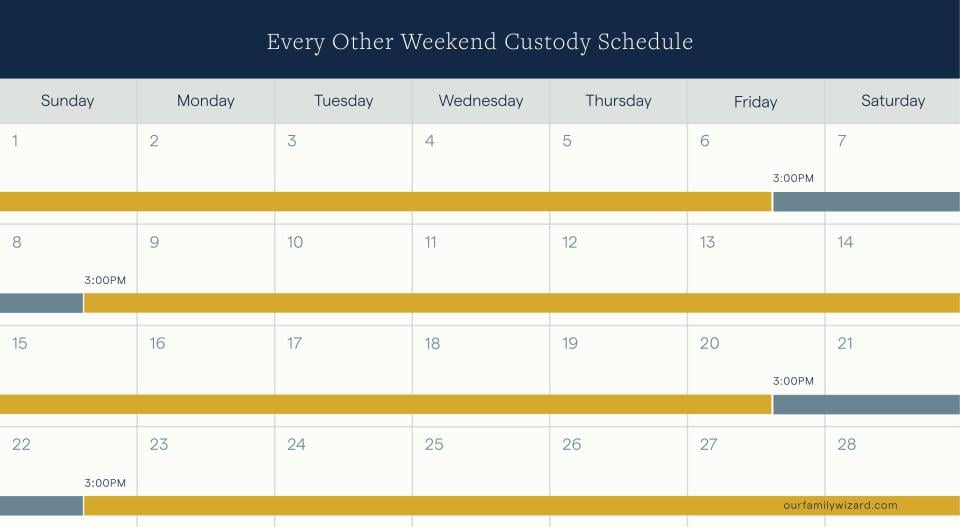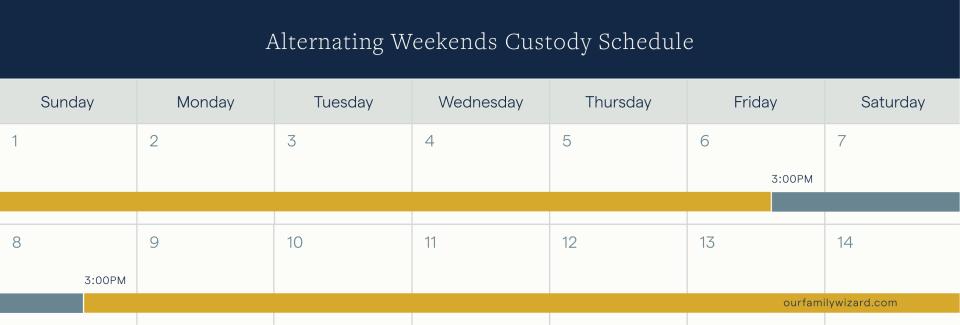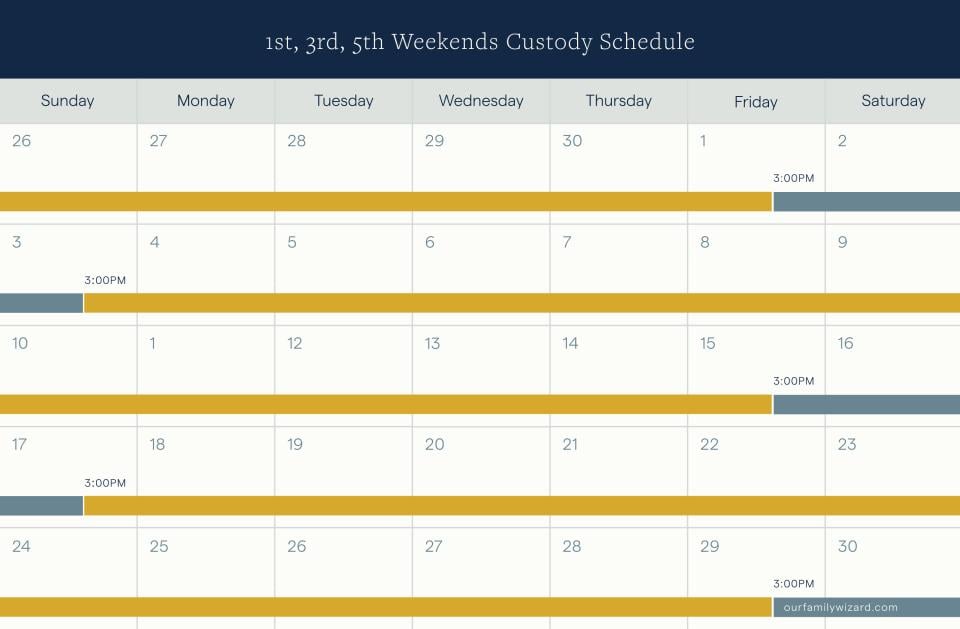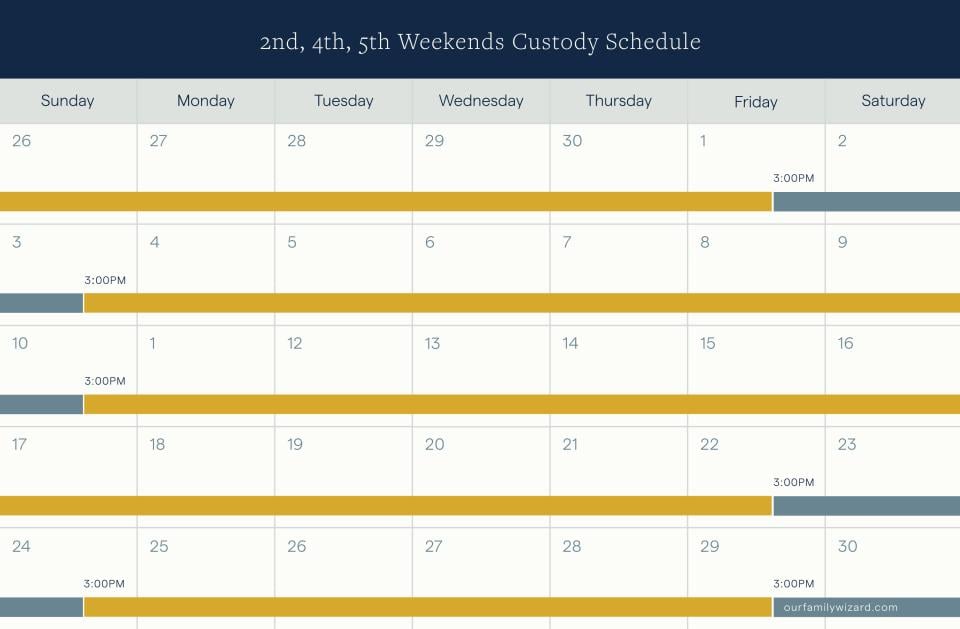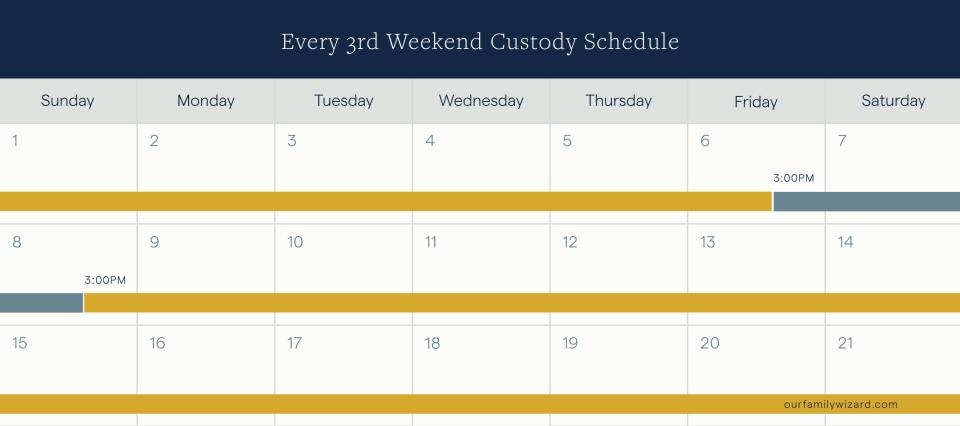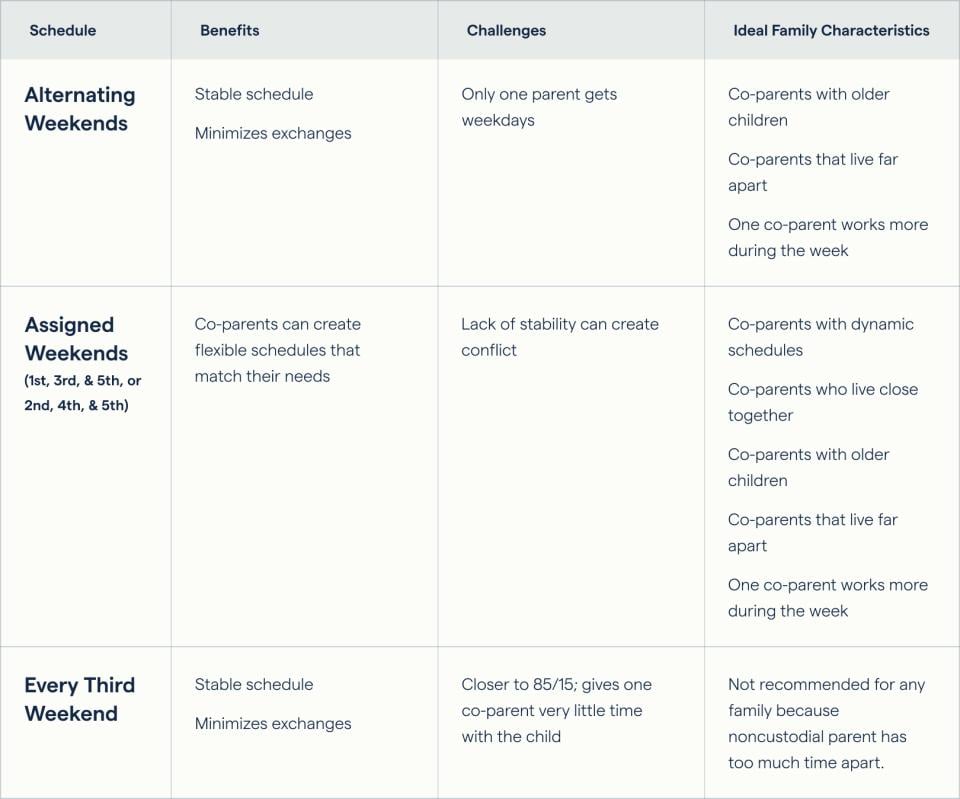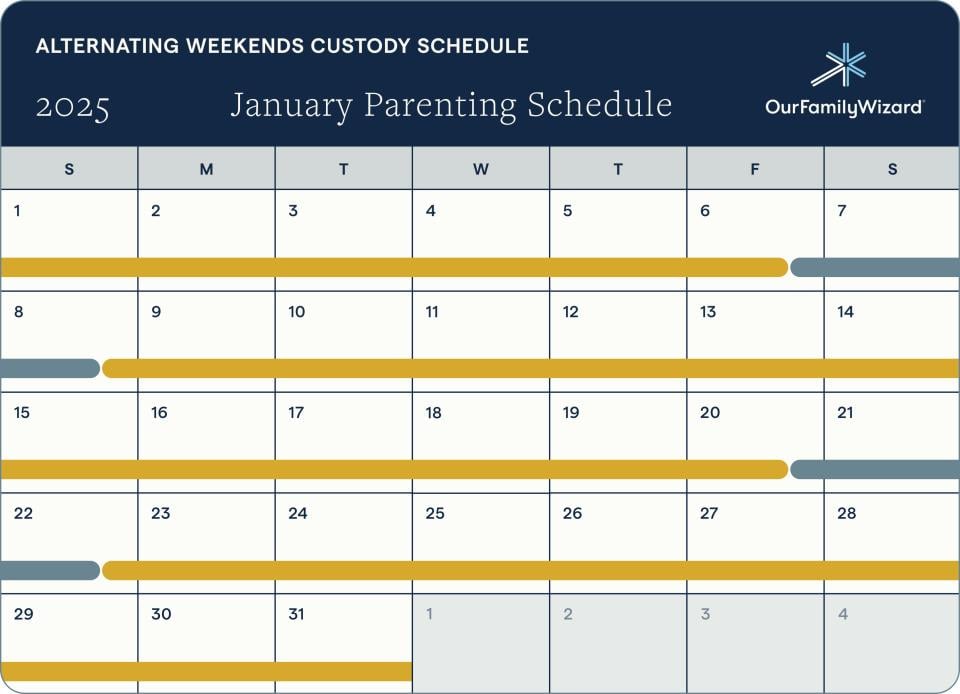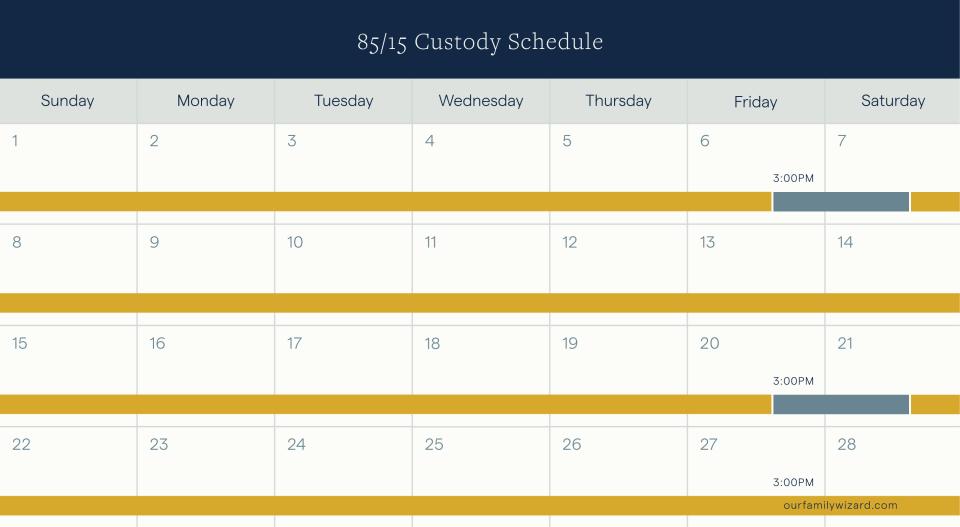80/20 Custody Schedules: Examples, Considerations, and Templates
For some families, sharing parenting time equally is not always a viable option. Check out our guide to the 80/20 custody schedule. Get expert tips and explore the pros and cons to decide if this plan will work for your family.
What Is an 80/20 custody schedule?
An 80/20 custody schedule splits physical custody so your child spends 80% of their time with one parent and 20% with the other. This schedule is best for parents who live far apart or when one parent has a demanding work schedule.
The 80/20 schedule is a type of joint physical custody or shared parenting time where co-parents share custody of their children. Under the 80/20 schedule, one parent acts as the primary parent and spends more time with their children. The other parent is still involved with their children but has significantly less physical custody time.
Compared with other schedules, like 50/50 and 60/40, the 80/20 plan features the most uneven distribution of parenting time. B ut it’s also offers one of the most straightforward custody schedules.
ut it’s also offers one of the most straightforward custody schedules.
“No one schedule fits all, and there are always situations that do not quite fit into a 'regular' routine,” says family law attorney Lisa Standish. "This type of schedule might look like the children spending time with one parent every other weekend throughout the year or two weekends per month.”
Co-parents generally select an 80/20 schedule when facing challenges like distance and work schedules. Even though the 80/20 can be a sensible choice for some families, non-custodial parents may push against it.
 “Many non-custodial co-parents resist an 80/20 schedule because they believe having less time with their child will make them a ‘lesser’ parent,” says family law attorney Aaron Weems. “The reality is that a parent faced with an 80/20 schedule needs to strongly consider whether that schedule is in the child’s best interests before they consider their own interests.”
“Many non-custodial co-parents resist an 80/20 schedule because they believe having less time with their child will make them a ‘lesser’ parent,” says family law attorney Aaron Weems. “The reality is that a parent faced with an 80/20 schedule needs to strongly consider whether that schedule is in the child’s best interests before they consider their own interests.”
Although 20% may seem too limited, experts say it’s still possible to build a strong relationship with a child in that time, especially when some weekday calls or dinners are added.
“The parent who has the children 20% of the time can bond with their children,” Standish says. “They just need to be diligent and creative about ways to maintain the close bond and relationship when they’re not physically present.”
Weems agrees: “Never make the fact that you have less time an excuse to be the lesser parent. Children can recognize quality over quantity, and if 20% is the best or most time available to you, then maximize the time with the child. Either you will be in a position to seek more time in the future, or you will have a strong parental role in your child’s life that will create the foundation for a positive relationship for the rest of your life.”
Key takeaways:
- The 80/20 parenting schedule can be effective for co-parents who live far apart or when one has a demanding schedule.
- However, the 80/20 schedule can cause strain and conflict over the imbalance.
- Co-parents have options within the 80/20 custody schedules.
- Co-parents can take steps to lessen the strain.
- A shared calendar app is the most efficient way to track and manage your schedule.
Simplify your 80/20 custody schedule
Keep your co-parenting organized with OurFamilyWizard.
What does an 80/20 custody schedule look like?
Co-parents can structure the 80/20 schedules in various ways. Commonly, the child spends most of the week with the co-parent with 80% custody and part of the weekends with the other parent. Technically, the non-custodial parent should receive three overnights every two weeks.
Experts advise building a 80/20 parenting time rotation over a two-week period. During this time, the primary parent will have custody for 11 overnights, while the non-custodial co-parent will have custody for three overnights. The co-parents will work together to decide how to structure these days, such as whether the three overnights should be consecutive or spaced throughout the two weeks.
Who does the 80/20 parenting plan work best for?
The 80/20 parenting plan works best in two situations. One is when parents live far apart. The other is when one has a demanding schedule.
 “The 80/20 parenting plan is best suited for families where one parent has significant work or other responsibilities which make it difficult or impossible for them to care for the children on a daily basis, or on weekdays,” says Andrea Mackaronis, Partner at Hoagland, Longo, Moran, Dunst & Doukas, LLP. “The 80/20 plan can be a compelling option when parents live an hour or more away from one another. As much as families would prefer to have more equality in parenting time, those schedules only work when the parents live nearby one another.”
“The 80/20 parenting plan is best suited for families where one parent has significant work or other responsibilities which make it difficult or impossible for them to care for the children on a daily basis, or on weekdays,” says Andrea Mackaronis, Partner at Hoagland, Longo, Moran, Dunst & Doukas, LLP. “The 80/20 plan can be a compelling option when parents live an hour or more away from one another. As much as families would prefer to have more equality in parenting time, those schedules only work when the parents live nearby one another.”
How many overnights are in an 80/20 custody split in a year?
In a 365-day year, like 2023, the co-parent with 80% custody will have 292 overnights, and the other co-parent will have 73 overnights. In a leap year, like 2024, the co-parent with primary custody will have 293 overnights. The non-custodial co-parent will still have 73 overnights.
80/20 custody schedule examples
One example of the 80/20 custody schedule is the alternating weekends calendar. The custodial parent has the children for the week, while the 20% parent has them every other weekend. Other 80/20 custody examples include every third weekend or the first, third, and fifth weekends.
Here are the ways that co-parents can create an 80/20 schedule:
Alternating weekends
In the alternating weekend schedule, the child lives with the custodial parent during the week and visits the non-custodial parent every other weekend.
Alternating weekends schedule
Assigned weekends
Assigned weekend schedules allow co-parents to predetermine their child custody schedule for the entire month.
If a Monday holiday follows the 20% parent’s weekend, many co-parents of school-aged children agree to extend the non-custodial parent's time with them.
- 1st, 3rd, and 5th weekends calendar
One of the most common ways to implement assigned weekend schedules is to give the parent with 20% custody time the first and third weekend of the month and the other parent the second and fourth weekend. If there is a fifth weekend that month, the child typically spends it with the 20% parent. However, co-parents should discuss this issue and define the decision on weekends within their parenting plan. The child spends the weekdays with the 80% parent.
1st, 3rd, 5th weekends schedule
- 2nd, 4th, and 5th weekends
This schedule is very similar to the 1st, 3rd, and 5th schedule, except that the non-custodial co-parent now has the 2nd and 4th weekends instead of the 1st and 3rd. Again, the non-custodial parent usually will have the children if there is a fifth weekend in the same month. The child spends the weekdays with the 80% parent.
2nd, 4th, 5th weekends schedule
Every 3rd weekend schedule
Under this schedule, the child will visit the 20% parent every third weekend. This schedule doesn’t mean the non-custodial co-parent will always get the third weekend of the month.
It’s easiest to think about this schedule from a three-month period. There are roughly 13 weeks in a three-month span, meaning that the non-custodial parent should spend four or five weekends with the children. This schedule is closer to an 85/15 split, because the non-custodial parent has around 15% custody and the custodial parent has around 85% custody.
Every 3rd weekend schedule
Weekend schedules with third-party time
In certain cases, co-parents may incorporate third-party time when the child is with someone other than either parent. This can include time spent at school or with another caregiver. By considering third-party time, co-parents aim to distribute the 80/20 split based on quality time rather than overall time.
For example, when you factor in this time, having the child spend one quality weekend with the custodial parent may approach an 80/20 split because the child spends much of the weekly time allocated to the custodial parent at school.
Co-parents can experiment with how third-party time affects their schedule by using 80/20 templates or a custody app to visualize how they can split quality time, not just time in general.
- Summer considerations
During holidays and the summer, many co-parents adjust the custody schedule to give the non-custodial parent additional time with the children. For instance, they may arrange for the children to spend two weeks with the non-custodial parent in addition to their regular alternating weekends.
80/20 custody schedule templates
Explore our 80/20 custody schedule templates to see which schedule will work best for your family. We design these templates to help you find the best 80/20 arrangement that meets your family’s needs.

Pros of 80/20 custody schedules
80/20 custody schedules offer several advantages. One is a consistent routine. Another is fewer exchanges. A third advantage is less conflict in tense relationships.
Most co-parents adopt the 80/20 schedule because it’s the most practical choice that meets their needs. It’s important to note that the reasons a co-parent adopts an 80/20 may differ. Some pros of 80/20 may seem like cons for some co-parents, and vice versa.
Here's a summary of the major pros of the 80/20 schedule.
- Stability and routine:
An 80/20 schedule provides a consistent routine for the child, as they spend most of their time with one parent. This stability also benefits the parents, who can anticipate their parenting needs clearly and plan work and social obligations accordingly.
- Minimizing disruption:
In cases where co-parents live far apart, or one has a demanding work schedule, an 80/20 schedule minimizes the disruptions of frequent transitions and long-distance travel.
- Provides the non-custodial parent with a balance of flexibility and parenting time:
The 20% parent can have more flexibility with personal time or career obligations. This type of flexibility often pushes one parent to sacrifice parenting time in return.
While the non-custodial parent spends less time with the child, they can still build a strong and meaningful relationship. Co-parents who want to maintain an engaged presence in their child’s life will make this plan work. For example, they can also use video chat apps to check in during the week.
- Reduced conflict for co-parents who find interacting difficult:
An 80/20 schedule can minimize conflict between co-parents, especially in tense situations.
“The 80/20 schedule minimizes the number of interactions the parents need to have with one another face-to-face, which can be a huge benefit if there is ongoing discord or animosity between the co-parents,” Mackaronis says. “By reducing the number of interactions that the co-parents need to have with one another, we also reduce the stress that parenting transitions can have on children in high-conflict families.”
Cons of 80/20 custody schedules
The main con of 80/20 custody schedules boils down to this: one parent has much less parenting time. The 80/20 schedule causes strain and conflicts for some families due to that imbalance.
Some people choose other custody arrangements due to these cons, while others decide the 80/20 is the most practical, especially if they periodically add time for the child with the non-custodial parent.
No matter what your initial thoughts may be, it is vital to approach any parenting agreement with a forward-thinking mindset. While certain issues may not be apparent at present, they could potentially arise in the future. Envision yourself in this schedule long-term and carefully evaluate the potential disadvantages.
Here’s a summary of the potential cons of an 80/20 parenting schedule:
- Significant imbalance in parenting time between co-parents:
With an 80/20 custody schedule, one parent has the child most of the time (80%) while the other co-parent has significantly less time (20%). This unequal distribution can be challenging for both parents. The 20% parent may feel disconnected from their child's daily life, and the 80% parent must take on most household tasks.
“The bulk of the responsibility for the children will fall upon the 80% parent,” says Mackaronis. “That means that they are on the hook for all of the ‘work’ of parenting—preparing meals, washing clothes, homework, activities, discipline. The list goes on.”
She adds: “The 20% parent may end up being the ‘fun’ parent who spoils the kids on their weekends, creating an unequal dynamic.”
- Increased potential for feelings of resentment for parent with less time:
The unequal split can create tension and disputes between co-parents. Even if the non-custodial parent advocated for 80/20, they may eventually feel marginalized or resentful. That may lead to conflicts over custody decisions, visitation rights, or other parenting-related matters. These conflicts can harm the co-parenting dynamic and, in turn, affect the child's well-being.
- Increased burden on the co-parent with 80% of the parenting time:
The custodial parent carries a heavier load of responsibilities. They typically must manage the child's daily routine, school activities, extracurricular commitments, and healthcare primarily on their own. This can cause significant stress and strain on their personal and professional life. It could become overwhelming.
- Strained relationship between the child and the non-custodial parent:
The reduced time between the child and the non-custodial parent can affect their relationship. Limited contact may make it harder for the non-custodial parent to establish and maintain a strong bond with their child. This concern is most relevant for very young children, who are still forming attachments to their parents. In contrast, co-parents with teenage children may find it easier to navigate an 80/20 split.
- Increased travel and logistical challenges:
If co-parents choose an 80/20 split because they live far apart, the children will travel two to three times a month. That can cause stress or fatigue for the child. The child also might miss out on important school or social outings. Also, some children may not adapt well to a new household or city.
With longer distances, the travel can create additional scheduling complexities and financial burdens for both co-parents.

Is an 80/20 schedule right for your family?
To see if an 80/20 schedule is right for your family, consider how it will affect your child. Then, reflect on work commitments, uneven parenting time and tasks, and the distance between homes.
Open conversations can help you and your co-parent identify and explore potential schedule and childcare issues. Here are some questions to help start your discussions about the 80/20 schedule.
- For the parent with 20% of custody time: Have you thoroughly considered your role and responsibilities in this arrangement?
- For both parents: How might the 80/20 arrangement affect the children, and is it in their best interest?
- For both: Are you open to including a clause for renegotiation if the circumstances of the parent with less custody time change and they desire more time?
- For both: If your children are quite young, is this schedule safe and suitable for their wellbeing?
- For both: How do you plan to ensure the parent with less custody time remains actively involved in the children's lives?
Schedules for families with special needs
Commonly recommended parenting schedules may be inappropriate for children with disabilities or special health, learning, or developmental needs. In many instances, the need for a consistent routine and stability in their schedule, plus the need for increased safety measures and supervision, may outweigh a custodial schedule with frequent changeovers between parents.
As always, parents need to carefully consider the particular needs of their children when creating custody schedules. Even if a commonly recommended parenting schedule isn’t the right fit for a family, parents can still maintain the consistency their children need while also finding creative ways to keep both parents connected and involved in their day-to-day lives.
Alternatives to 80/20 custody schedules
Alternatives to the 80/20 custody schedule include the 85/15 schedule and the 70/30 schedule. The 85/15 gives the non-custodial parent a little less time than the 80/20, while the 70/30 gives them a little more.
Here’s a closer look at these two alternatives to 80/20.
- 85/15 custody schedule: One day a week
The 85/15 schedule is rare, and most co-parenting experts don’t recommend this plan because it gives the non-custodial parent very little time with the children. One way to create an 85/15 split is to give the non-custodial co-parent one overnight a week. Another option that closely approximates an 85/15 schedule is the "every third weekend" arrangement.
85/15 custody schedule (one day a week)
- 70/30 custody schedule
Under a 70/30 schedule, the non-custodial parent has 30% of the parenting time, and the custodial parent has 70%. Usually, co-parents use the 5-2 (or “every weekend”) weekly schedule, where the custodial parent has the child during the week, and the non-custodial parent has the weekend.
Every weekend custody schedule, the most popular 70/30 rotation
Scheduling tips for 80/20 parenting plans
To make 80/20 custody plans work, follow the advice of experts. Use technology to stay connected, try to balance parenting responsibilities, and be flexible to allow the custodial parent extra time when possible.
Here are scheduling tips to help co-parents with 80/20 parenting plans.
- Ensure the non-custodial parent has chances to connect with the children. As Standish says, it’s important for the parent with less time to be diligent and creative about finding ways to maintain the close bonds with their children. Here are some ideas for ways for a non-custodial parent to connect:
- For long-distance co-parenting: Schedule video or phone chats
Mackaronis says that the 80/20 plan might make the 20% parent feel that they’re missing out on their children’s lives. “One way to ensure that children feel involved and connected with the 20% is to have scheduled telephone calls and video-chats on a regular basis. The parent that has the child can initiate the contact to foster the relationship between the child and the 20% parent, rather than having the child feel like the calls are their burden to initiate, or a disruption.”
Weems agrees with Mackaronis and adds, “Due to the limited in person interaction in this type of schedule communication with the child will be important: the use of video calls, messaging apps, or other ways to connect (such as playing online video games together), need to be a significant component to this type of schedule.”
- For local co-parenting: Incorporate weekly dinners
Weems recommends that co-parents who don’t live too far from one another consider weekly dinners or events with the child. “If the co-parents live nearby, the non-custodial parent should consider scheduling dinner visits when possible. Not only will this serve to break up the periods when there is less physical custody, but it will also help normalize the child seeing the other parent during periods beyond the weekend custodial time.”
- Add language or negotiating terms in case the 20% co-parent wants to reconsider
If the parents move closer together, the non-custodial parent might want to change the schedule to have more parenting time. Consider including a renegotiation clause in your parenting plan addressing this scenario to facilitate such discussions. This clause can serve as a guide for navigating potential adjustments to the custody arrangement.
- Try to spread our parenting responsibilities as evenly as possible
“The co-parents should communicate with one another to make sure they are on the same page with routines, activities, homework, and discipline,” says Mackaronis. “That way, the rules and guidelines follow the children wherever they are.”
Weems agrees: “The non-custodial parent’s involvement has to be an integrated part of the child’s routine. Establish methods for frequent contact and make sure that the 20% co-parent has a way to remain connected to events for school and extracurricular activities."
The easiest way to manage an 80/20 schedule
Custody schedules may sound easy, but making them work can be tough. An 80/20 parenting schedule can come with challenges that require a lot of flexibility, cooperation, and communication.
With tools like the OurFamilyWizard Calendar, putting your 80/20 plan into action becomes simple. This shared calendar is tailor-made for co-parents, helping to erase any confusion that can pop up from juggling multiple, separate calendars. Whether it's tweaking your schedule for a few days or adding an extra dinner to keep your 80/20 schedule balanced, features in the Calendar like the schedule change request form make one-time adjustments simple.
And when you want to chat with your child or co-parent, the Calls feature helps you stay connected when apart. Audio and video calling directly through the OurFamilyWizard app ensures that all calls are documented so that you can keep a record of virtual parenting time with your child or conversations with your co-parent.
Assigned Weekends Co-Parenting Schedule FAQs
Explore frequently asked questions about 80/20 custody schedules, which works for some, families depending on work schedules or the child's needs. Learn which parent is more likely to get 80% and how an 80/20 split affects child support.
How often should a non-custodial parent see their child?
Ideally, a non-custodial parent should see their child as often as possible. Sometimes, that means an 80/20 split. The parent with 20% parenting time can make the most of that time by staying present and engaged.
What age is good for an 80/20 custody schedule?
Preteens and teenagers can usually tolerate an 80/20 schedule, since they are somewhat independent, and it’s easier for them to adjust than younger kids. Younger kids might struggle with the longer gaps between seeing the parent with 20% time.
Is every other weekend reasonable access?
In an 80/20 custody split, the every-other-weekend pattern is generally considered “reasonable access” for a lot of families The parent with 20% does see the children on a regular, scheduled basis, even though it is not frequent.
Is 80% of parenting time considered primary custody?
If you have 80% parenting time, that is usually considered full custody. The exact percentage that's considered full custody depends on your jurisdiction. A parent might have full custody with 51% of parenting time, or they may need more.
Who is more likely to get 80%, the mother or the father?
For most judges, deciding on an 80/20 split depends on the parents’ work schedules and distance from each other, not their genders. Historically, the mother was more likely to receive a higher percentage, but that trend is fading away.
How does an 80/20 schedule affect the children?
An 80/20 custody schedule can make it more difficult for the children to bond with the parent who has 20%. However, it’s possible for that parent to maximize bonding during their parenting time and maintain healthy relationships with their children.
How does an 80/20 schedule affect child support?
A parent who has 20% parenting time will typically pay more child support than they would if they had 30%, 40%, or 50% parenting time. The exact calculation depends on both parents’ incomes as well as many other complicated factors.
A Note on Terminology
In general, the term “physical custody” refers to which parent a child lives with. Today, many experts use other terms to describe this arrangement, like “parenting schedule” or “parenting time arrangement.” These new terms better represent a relationship and the parent’s responsibilities for their children. But just a heads up: this article uses these older and newer terms interchangeably.

